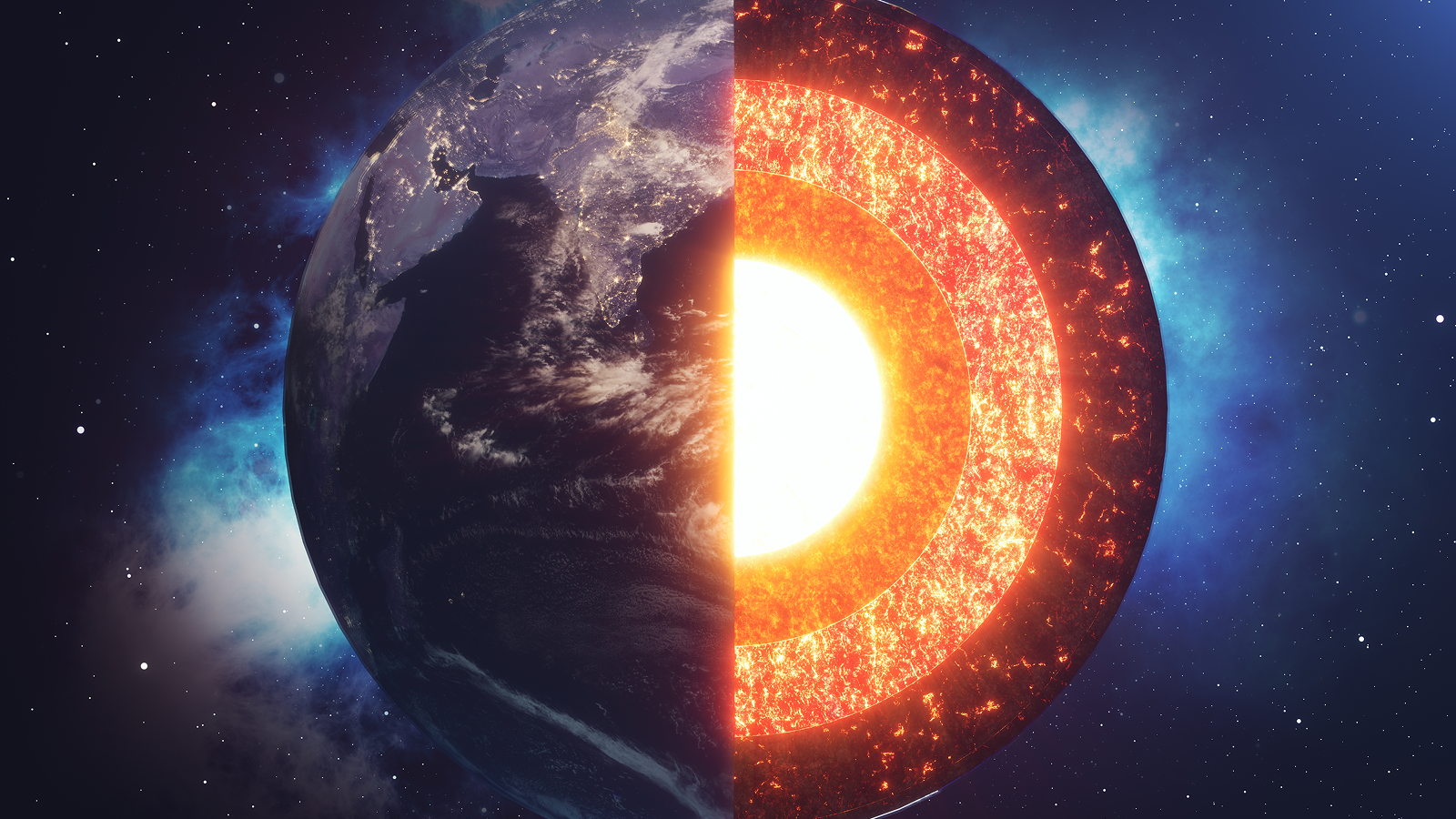By Alfred Wilson-Spencer
Copyright livescience

Skip to main content
Close main menu
Live Science
Sign up to our newsletter
View Profile
Search Live Science
Planet Earth
Archaeology
Physics & Math
Human Behavior
Science news
Life’s Little Mysteries
Science quizzes
Newsletters
Story archive
Lab brains could become conscious
Jaguar smashes swim record
Mysterious hand positions on Maya alter
It’s too late to stop AI, readers say
Anthropologist Ella Al-Shamahi on human origins
Don’t miss these
Enormous blobs deep beneath Earth’s surface appear to drive giant volcanic eruptions
Study raises major questions about Earth’s ‘oldest’ impact crater
Scientists heat gold to 14 times its melting point — without turning it into a liquid
The geology that holds up the Himalayas is not what we thought, scientists discover
Vast source of rare Earth metal niobium was dragged to the surface when a supercontinent tore apart
World’s oldest rocks could shed light on how life emerged on Earth — and potentially beyond
Mercury’s ‘missing’ meteorites may have finally been found on Earth
Planet Earth
Scientists discover that mysterious giant structures beneath the North Sea seemingly defy what we know about geology
The hunt for ‘Planet Nine’: Why there could still be something massive at the edge of the solar system
Dozens of mysterious blobs discovered inside Mars may be the remnants of ‘failed planets’
400-mile-long chain of fossilized volcanoes discovered beneath China
When did our solar system’s planets form? Discovery of tiny meteorite may challenge the timeline
NASA reveals the dwarf planet Ceres had a hidden ‘energy source’ that may have sparked alien life
Planet Earth
‘Pulsing, like a heartbeat’: Rhythmic mantle plume rising beneath Ethiopia is creating a new ocean
Earth, Mars, Venus — and a long-lost planet — may have once ‘waltzed’ in perfect harmony around the sun
Planet Earth
We are just beginning to discover what Earth’s inner core is really made of
Alfred Wilson-Spencer
21 September 2025
Earth’s core cannot be made just of iron — it also appears to contain carbon. And our research suggests it may contain a bit of oxygen and possibly silicon as well.
When you purchase through links on our site, we may earn an affiliate commission. Here’s how it works.
Earth’s solid inner core cannot just be made of iron. So what else does it contain?
(Image credit: Rost-9D/Getty Images)
The iron-rich core at the centre of our planet has been a crucial part of Earth’s evolution. The core not only powers the magnetic field which shields our atmosphere and oceans from solar radiation, it also influences plate tectonics which have continually reshaped the continents.
But despite its importance, many of the most fundamental properties of the core are unknown. We do not know exactly how hot the core is, what it is made of or when it began to freeze. Fortunately, a recent discovery by me and my colleagues brings us much closer to answering all three of these mysteries.
We know the temperature of Earth’s inner core is very roughly about 5,000 Kelvin (K) (4,727°C). It was once liquid, but has cooled and become solid over time, expanding outwards in the process. As it cools, it releases heat to the overlying mantle, driving the currents behind plate tectonics.
You may like
Enormous blobs deep beneath Earth’s surface appear to drive giant volcanic eruptions
Study raises major questions about Earth’s ‘oldest’ impact crater
Scientists heat gold to 14 times its melting point — without turning it into a liquid
This same cooling also generates the Earth’s magnetic field. Most of the field’s energy today comes from freezing the liquid part of the core and growing the solid inner core at its centre.
However, because we cannot access the core, we have to estimate its properties to understand how it is cooling.
A key part of understanding the core is knowing its melting temperature. We know where the boundary between the solid inner core and liquid outer core is from seismology (the study of earthquakes). The temperature of the core must equal its melting temperature at this location, because this is where it is freezing. So, if we know what the melting temperature is exactly, we can find out more about the exact temperature of the core — and what it’s made of.
Mysterious chemistry
Traditionally, we have two ways to figure out what the core is made of: meteorites and seismology. By examining the chemistry of meteorites — which are thought to be pieces of planets that never formed, or pieces of the cores of destroyed Earth-like planets — we can get an idea of what our core could be made of.
Sign up for the Live Science daily newsletter now
Get the world’s most fascinating discoveries delivered straight to your inbox.
Contact me with news and offers from other Future brandsReceive email from us on behalf of our trusted partners or sponsorsBy submitting your information you agree to the Terms & Conditions and Privacy Policy and are aged 16 or over.
The problem is that this only gives us a rough idea. Meteorites show us that the core should be made of iron and nickel, and maybe a few percent of silicon or sulphur, but it’s difficult to be more specific than this.
Seismology, on the other hand, is far more specific. When the sound waves from earthquakes travel through the planet, they speed up and slow down depending on what materials they pass through. By comparing the travel time of these waves, from earthquake to seismometer, with how fast waves travel through minerals and metals in experiments, we can get an idea of what the interior of the Earth is made of.
It turns out these travel times require that the Earth’s core is about 10% less dense than pure iron, and that the liquid outer core is denser than the solid inner core. Only some known chemistry of the core can explain these properties.
You may like
Enormous blobs deep beneath Earth’s surface appear to drive giant volcanic eruptions
Study raises major questions about Earth’s ‘oldest’ impact crater
Scientists heat gold to 14 times its melting point — without turning it into a liquid
But even among a small selection of possible constituents, the potential melting temperatures vary by hundreds of degrees — leaving us none the wiser about the precise properties of the core.
A new constraint
In our new research, we’ve used mineral physics to study how the core might first have begun to freeze, discovering a new way to understand the chemistry of the core. And this approach appears to be even more specific than seismology and meteorites.
Research simulating how atoms in liquid metals come together to form solids has found that some alloys require more intense “supercooling” than others. Supercooling is when a liquid is cooled below its melting temperature. The more intense the supercooling, the more often atoms will come together to form solids, making a liquid freeze faster. A water bottle in your freezer can be supercooled to -5°C for hours before freezing, whereas hail forms in minutes when water droplets are cooled to -30°C in clouds.
By exploring all possible melting temperatures of the core, we find that the most supercooled the core could have been is around 420°C below the melting temperature — any more than this and the inner core would be larger than seismology finds it to be. But pure iron requires an impossible ~1000°C of supercooling to freeze. If cooled this much, the entire core would have frozen, contrary to seismologists’ observations.
Adding silicon and sulphur, which both meteorites and seismology suggest could be present in the core, only make this problem worse — requiring even more supercooling.
Our new research explores the effect of carbon in the core. If 2.4% of the core’s mass was carbon, around 420°C of supercooling would be needed to begin freezing the inner core. This is the first time that freezing of the core has been shown to be possible. If the carbon content of the core was 3.8%, only 266°C of supercooling is needed. This is still a lot, but far more plausible.
RELATED STORIES
—Scientists discover Earth’s inner core isn’t just slowing down — it’s also changing shape
—’New hidden world’ discovered in Earth’s inner core
—Earth’s rotating inner core is starting to slow down — and it could alter the length of our days
This new finding shows that while seismology can narrow the possible chemistry of the core down to several different combinations of elements, many of these cannot explain the presence of the solid inner core at the centre of the planet.
The core cannot be made just of iron and carbon because the seismic properties of the core require at least one more element. Our research suggests it is more likely to contain a bit of oxygen and possibly silicon as well.
This marks a significant step toward understanding what the core is made of, how it started freezing, and how it has shaped our planet from the inside out.
This edited article is republished from The Conversation under a Creative Commons license. Read the original article.
What’s inside Earth quiz: Test your knowledge of our planet’s hidden layers
Alfred Wilson-Spencer
Research fellow of Mineral Physics, University of Leeds
My principal area of research is the key processes in the metallic cores and magma oceans of rocky planets which facilitate habitable conditions at the surface. I work within the Leeds Centre for Planetary Cores but collaborate broadly, so if you have ideas, I’m all ears! Feel free to send me an email or catch me at a conference. I am regularly at the AGU and EGU annual meetings and help organise the Mineral Physics Group Research in Progress meetings.
You must confirm your public display name before commenting
Please logout and then login again, you will then be prompted to enter your display name.
Enormous blobs deep beneath Earth’s surface appear to drive giant volcanic eruptions
Study raises major questions about Earth’s ‘oldest’ impact crater
Scientists heat gold to 14 times its melting point — without turning it into a liquid
The geology that holds up the Himalayas is not what we thought, scientists discover
Vast source of rare Earth metal niobium was dragged to the surface when a supercontinent tore apart
World’s oldest rocks could shed light on how life emerged on Earth — and potentially beyond
Latest in Planet Earth
Vast source of rare Earth metal niobium was dragged to the surface when a supercontinent tore apart
‘This needs to happen fast’: Scientists race to cryopreserve a critically endangered tree before it goes extinct
Volcanic ‘googly eyes’ stare into space from skull-like peninsula
‘New’ island emerges from melting ice in Alaska
‘Serious adverse and unintended consequences’: Polar geoengineering isn’t the answer to climate change
Action on climate change faces new threat: The doomers who think it’s too late to act
Latest in Opinion
We are just beginning to discover what Earth’s inner core is really made of
‘When people gather in groups, bizarre behaviors often emerge’: How the rise of online social networks has catapulted dysfunctional thinking
‘Your fear is well-founded’: How human activities have raised the risk of tick-borne diseases like Lyme
How the surface you exercise on might increase your risk of cramps
TRAPPIST-1e might have an atmosphere, JWST hints
RFK Jr. wants to overhaul the country’s ‘vaccine court.’ Here’s what stands in his way.
LATEST ARTICLES
Did ancient Egyptians really booby-trap the pyramids?
Owning a cat will change your brain. Here’s how.
‘Shocking’: Black hole found growing at 2.4 times the theoretical limit
Paralvinella hessleri: The yellow worm that lives in acid and fights poison with poison
WANDRD PRVKE Lite camera backpack review
Live Science is part of Future US Inc, an international media group and leading digital publisher. Visit our corporate site.
Contact Future’s experts
Terms and conditions
Privacy policy
Cookies policy
Accessibility Statement
Advertise with us
Web notifications
Editorial standards
How to pitch a story to us
Future US, Inc. Full 7th Floor, 130 West 42nd Street,
Please login or signup to comment
Please wait…



